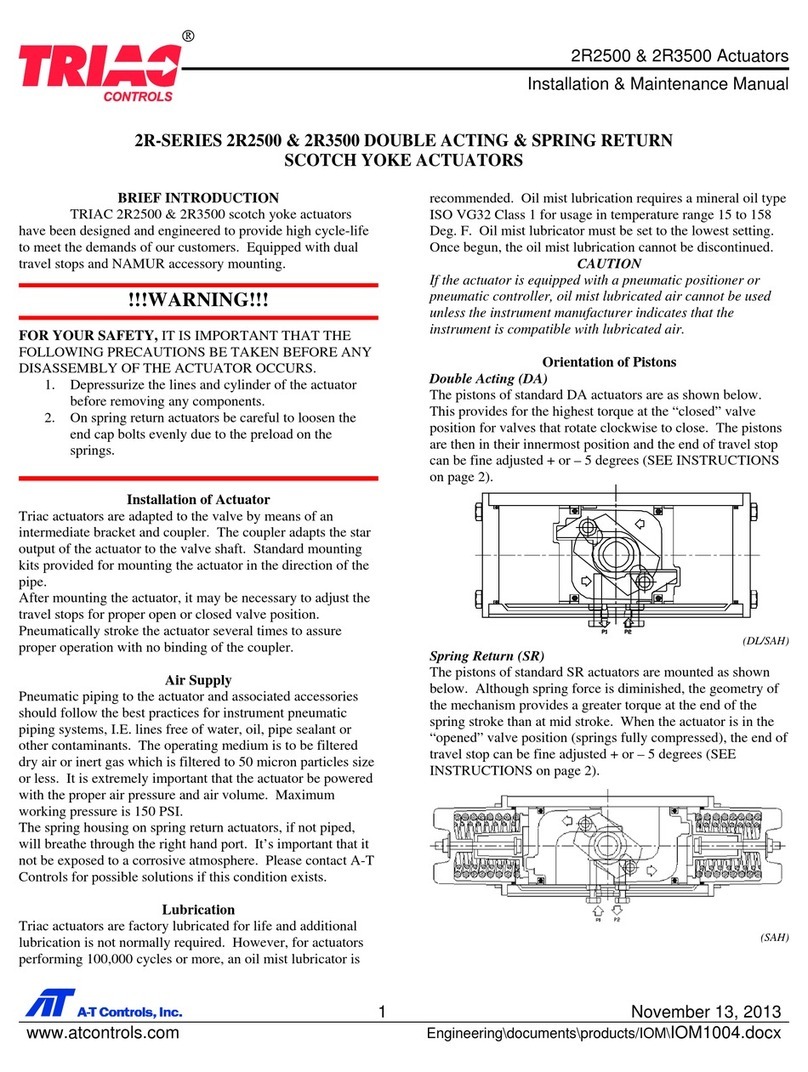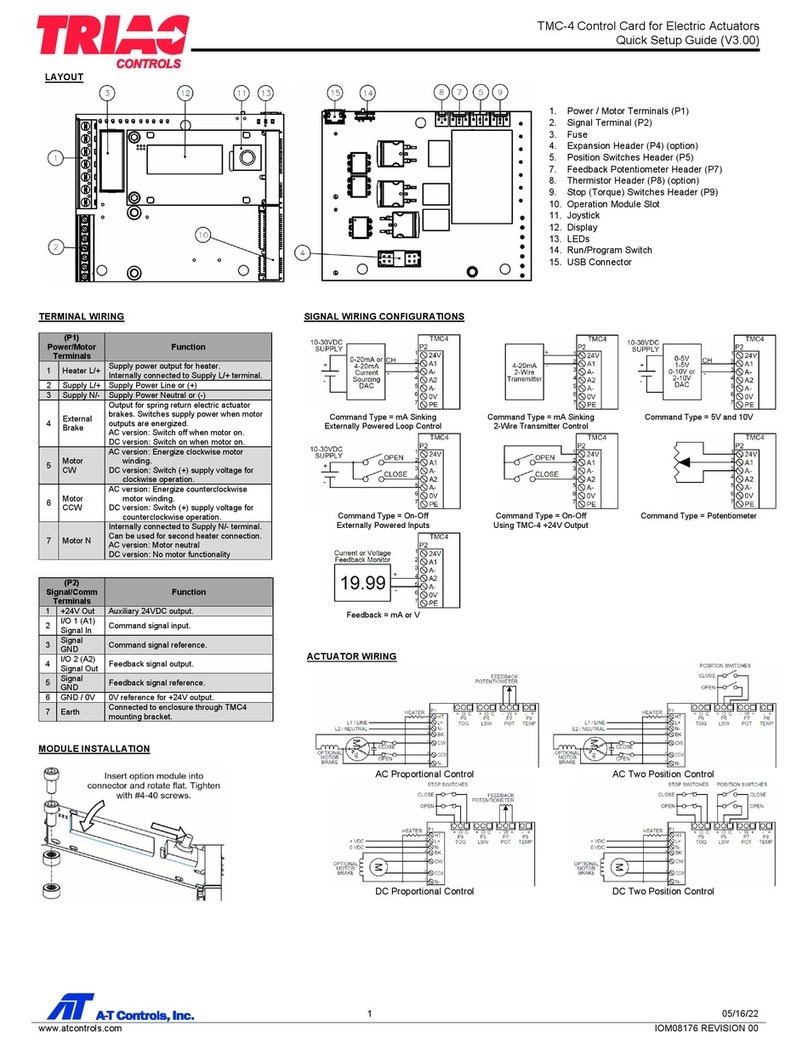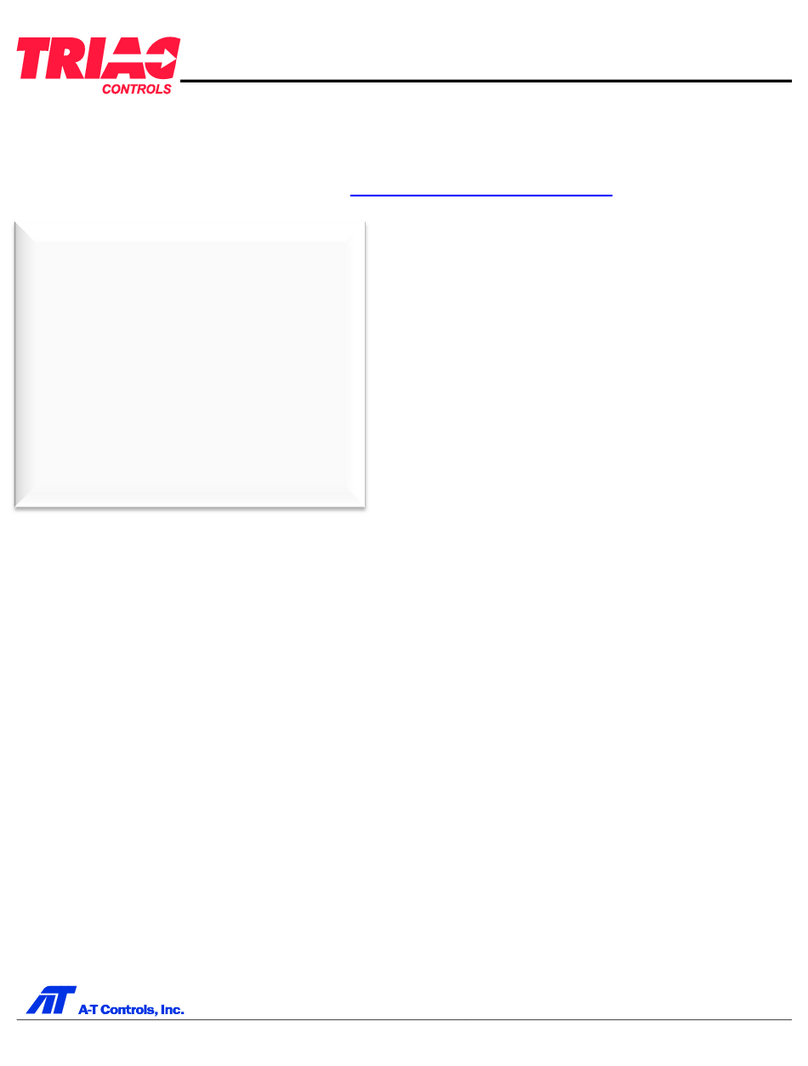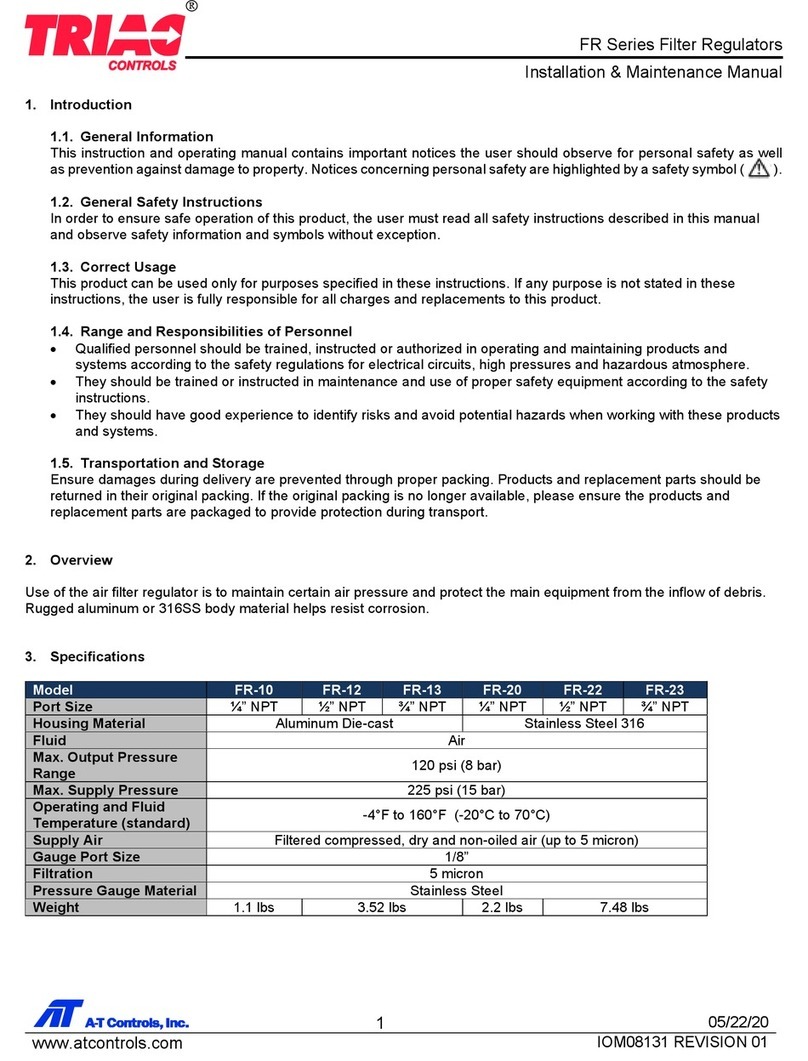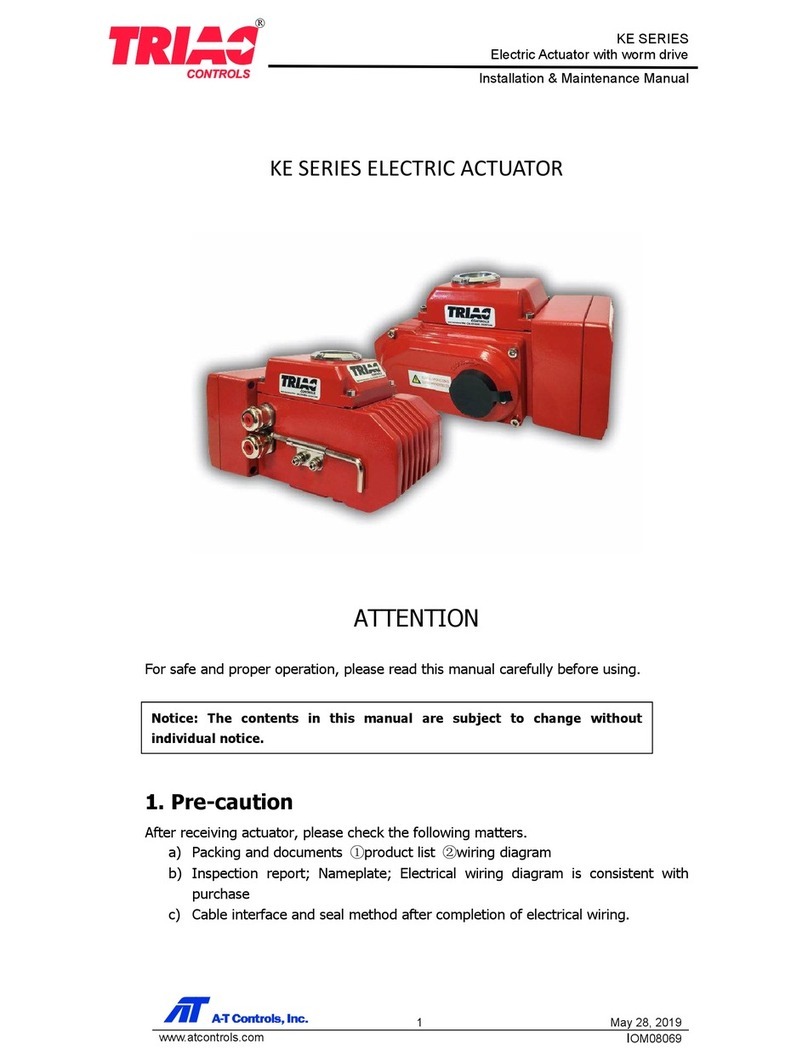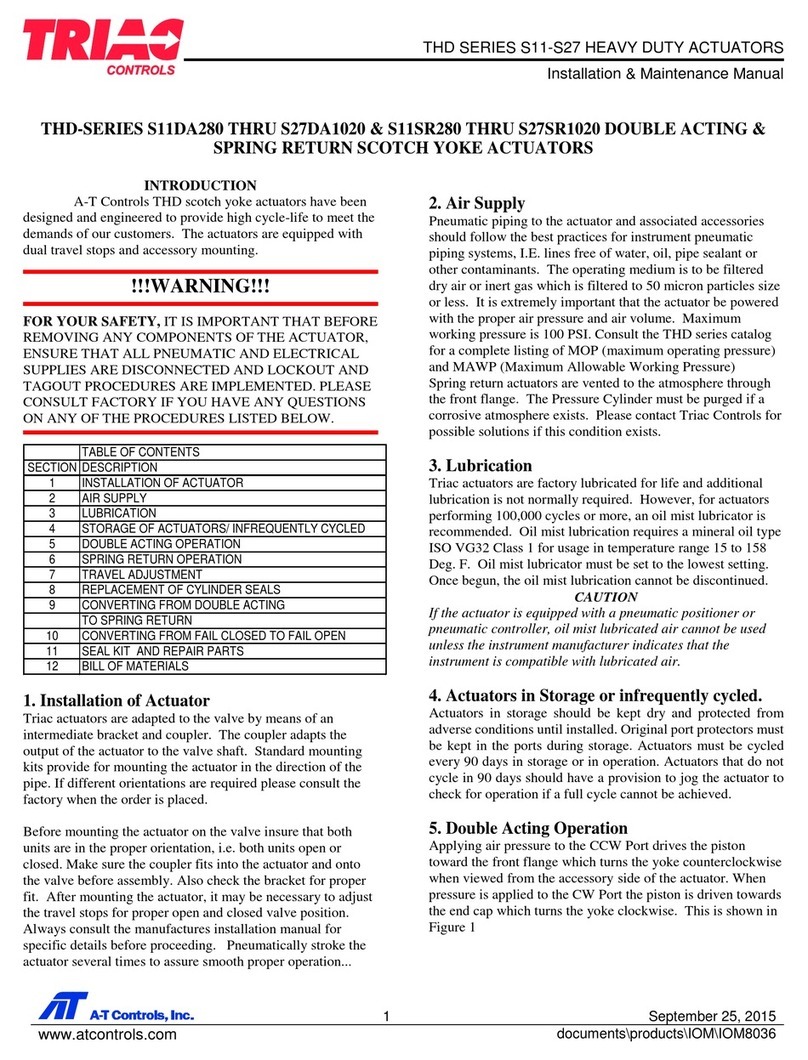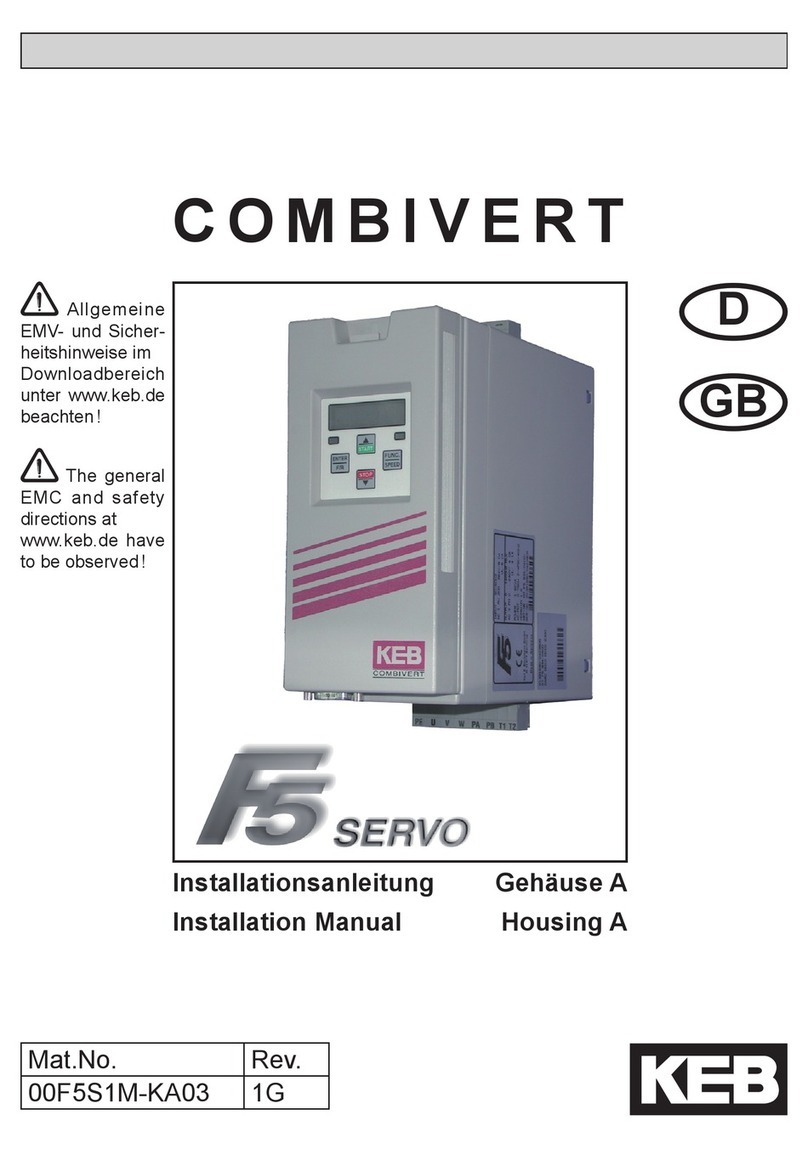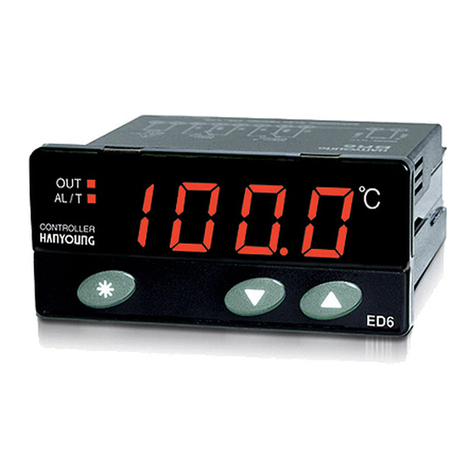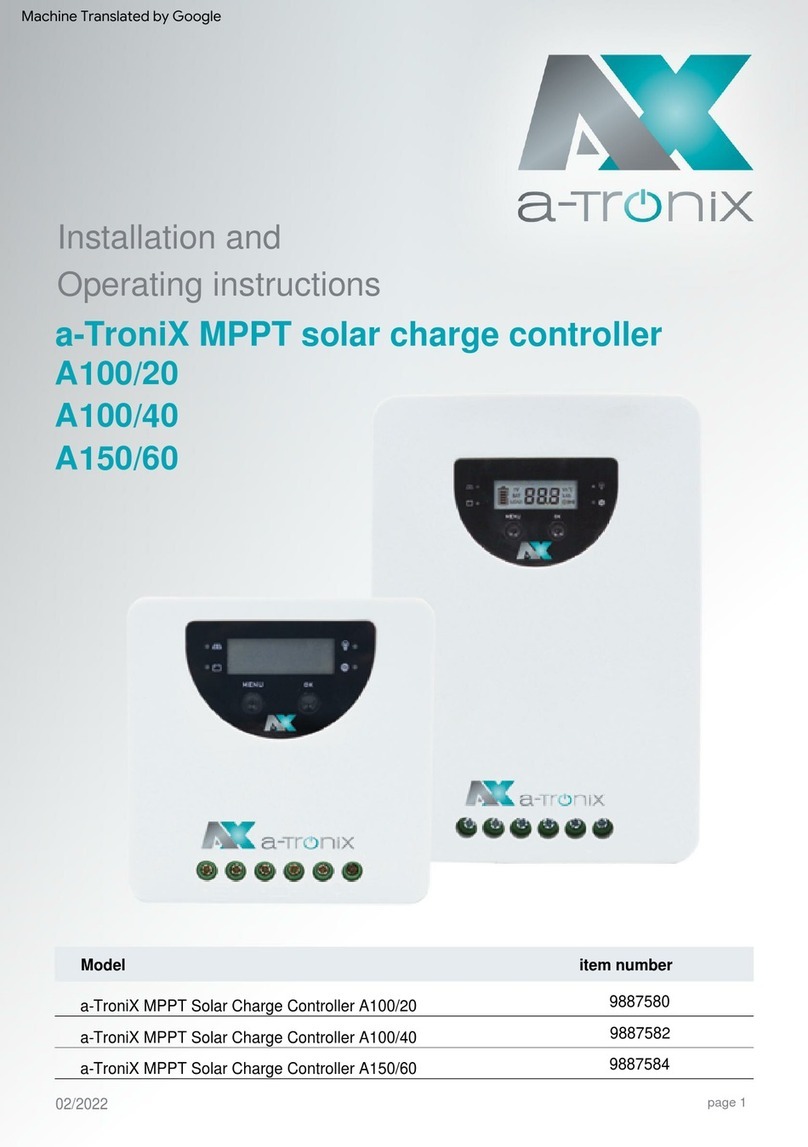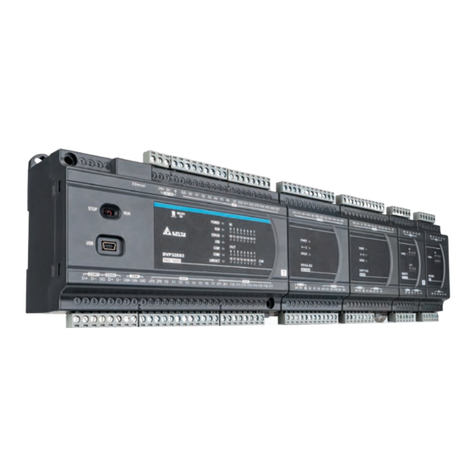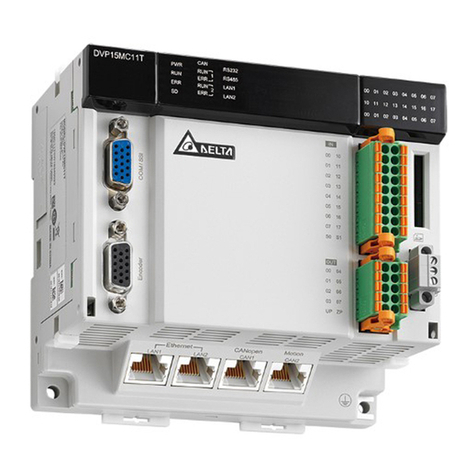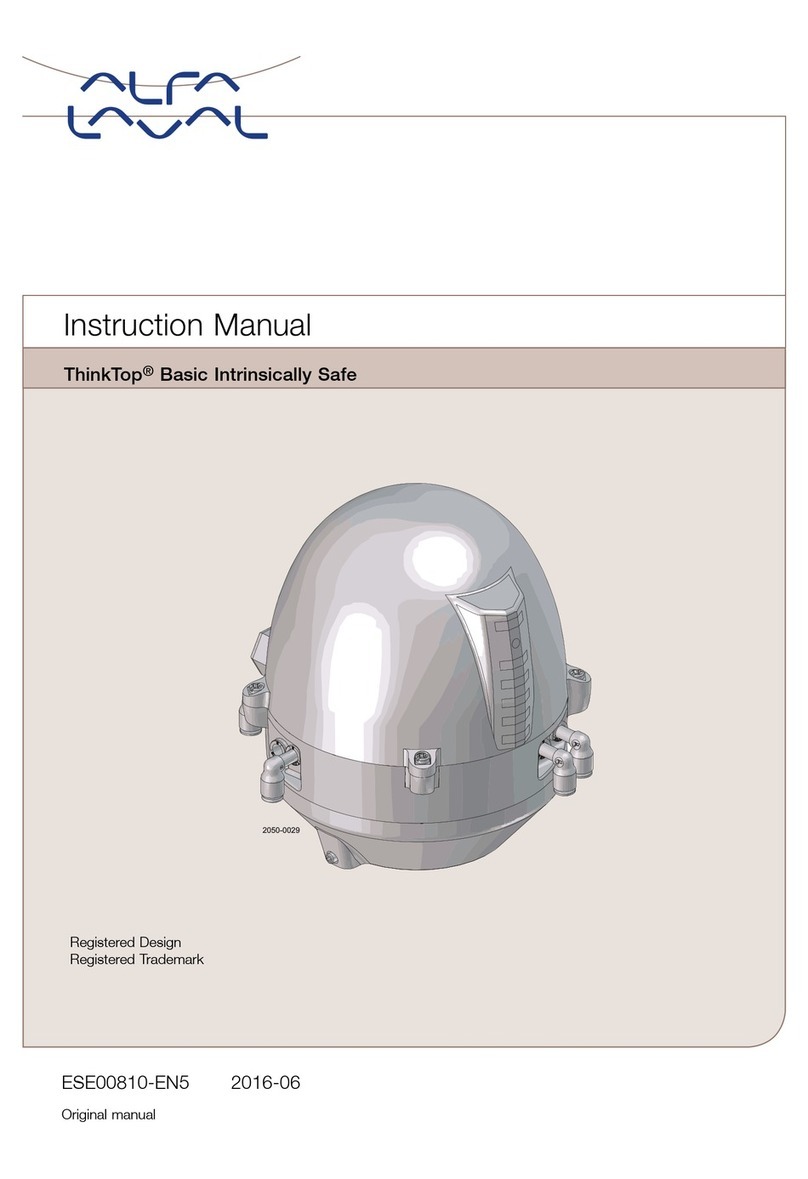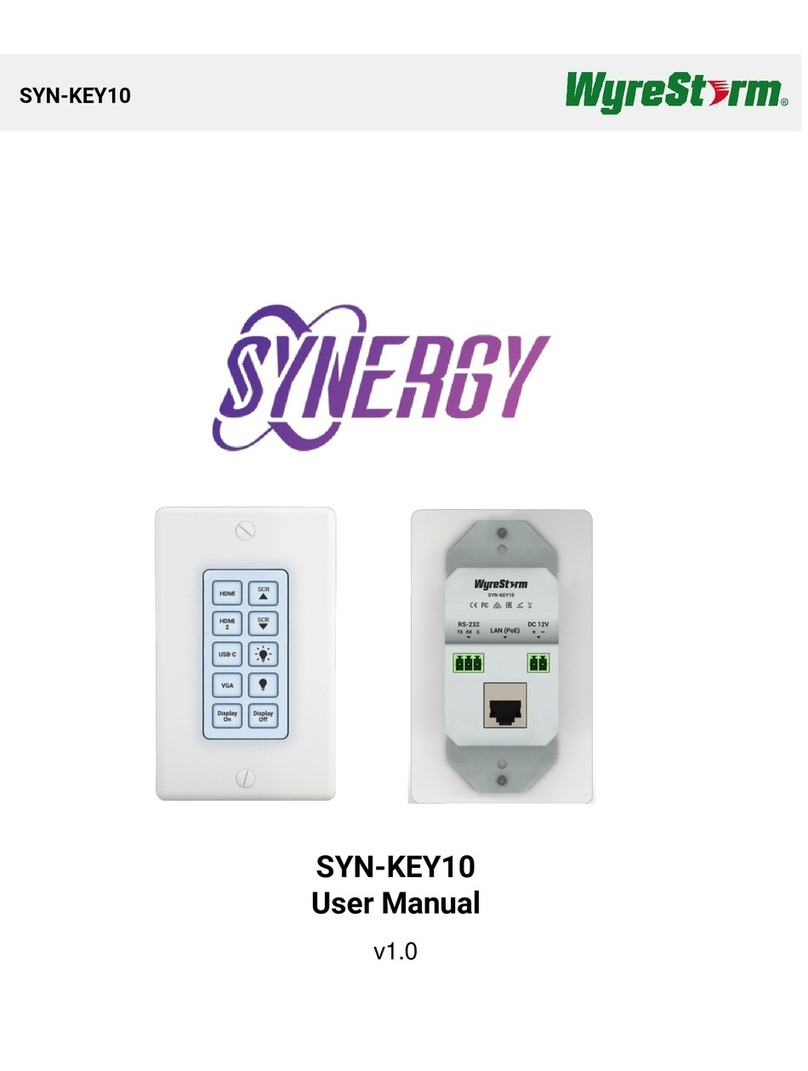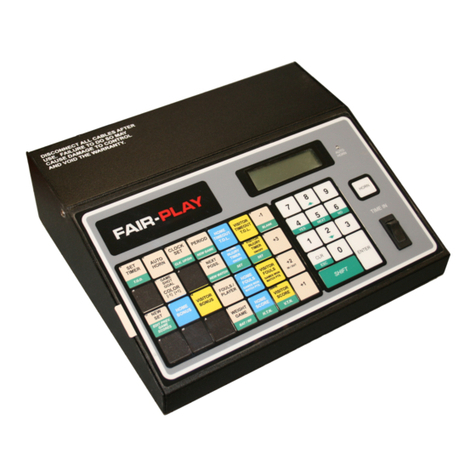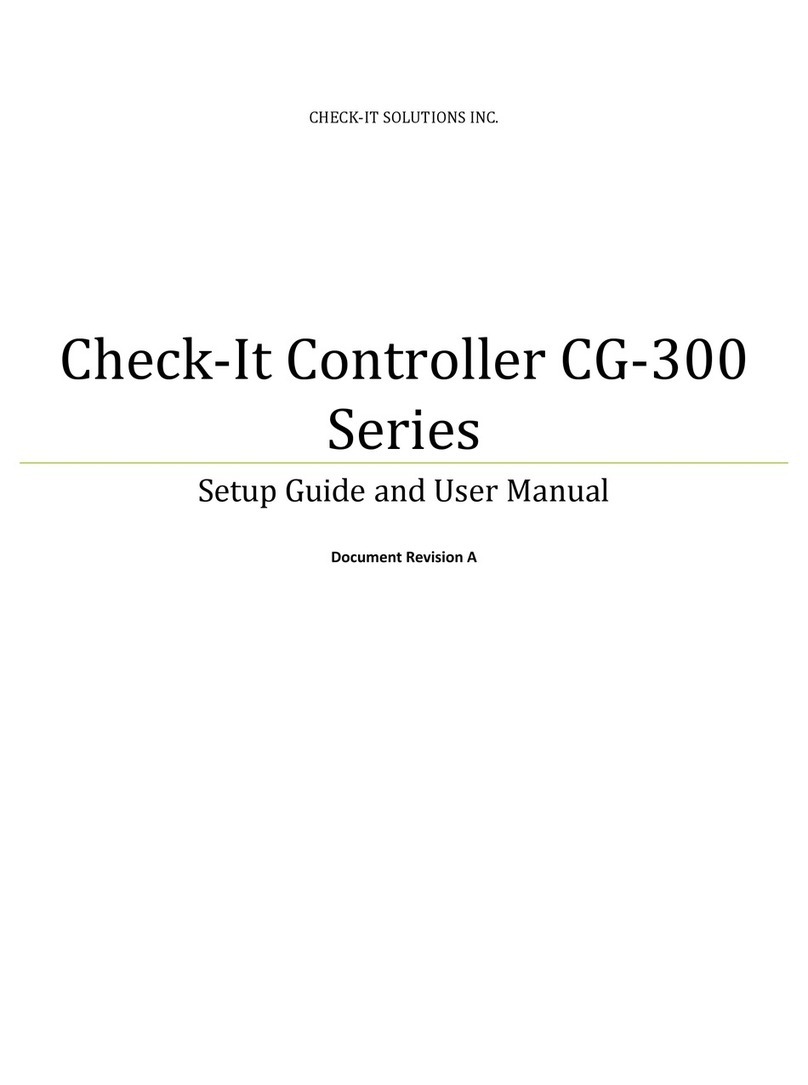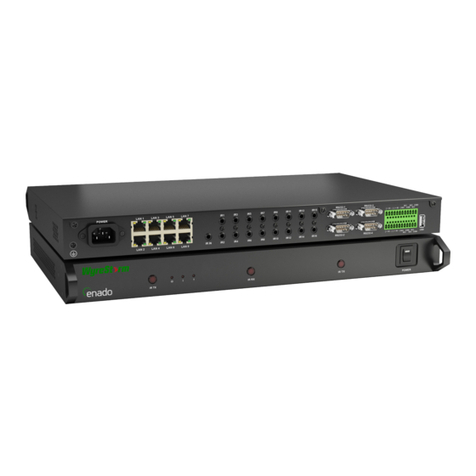TRIAC THD S09 SERIES Instruction Manual

THD SERIES S09 HEAVY DUTY ACTUATORS
Installation & Maintenance Manual
1
September 25, 2015
www.atcontrols.com
documents\products\IOM\IOM8037
THD-SERIES S09DA200 THRU S09DA385 & S09SR200 THRU S09SR385 DOUBLE ACTING &
SPRING RETURN SCOTCH YOKE ACTUATORS
INTRODUCTION
A-T Controls THD scotch yoke actuators have been designed
and engineered to provide high cycle-life to meet the demands
of our customers. The actuators are equipped with dual travel
stops and accessory mounting.
!!!WARNING!!!
FOR YOUR SAFETY, IT IS IMPORTANT THAT BEFORE
REMOVING ANY COMPONENTS OF THE ACTUATOR,
ENSURE THAT ALL PNEUMATIC AND ELECTRICAL
SUPPLIES ARE DISCONNECTED AND LOCKOUT AND
TAGOUT PROCEDURES ARE IMPLEMENTED. PLEASE
CONSULT FACTORY IF YOU HAVE ANY QUESTIONS
ON ANY OF THE PROCEDURES LISTED BELOW.
1. Installation of Actuator
Triac actuators are adapted to the valve by means of an
intermediate bracket and coupler. The coupler adapts the
output of the actuator to the valve shaft. Standard mounting
kits provide for mounting the actuator in the direction of the
pipe. If different orientations are required please consult the
factory when the order is placed.
Before mounting the actuator on the valve insure that both
units are in the proper orientation, i.e. both units open or
closed. Make sure the coupler fits into the actuator and onto
the valve before assembly. Also check the bracket for proper
fit. After mounting the actuator, it may be necessary to adjust
the travel stops for proper open and closed valve position.
Always consult the manufactures installation manual for
specific details before proceeding. Pneumatically stroke the
actuator several times to assure smooth proper operation.
2. Air Supply
Pneumatic piping to the actuator and associated accessories
should follow the best practices for instrument pneumatic
piping systems, I.E. lines free of water, oil, pipe sealant or
other contaminants. The operating medium is to be filtered
dry air or inert gas which is filtered to 50 micron particles size
or less. It is extremely important that the actuator be powered
with the proper air pressure and air volume. Maximum
working pressure is 100 PSI. Consult the THD series catalog
for a complete listing of MOP (maximum operating pressure)
and MAWP (Maximum Allowable Working Pressure)
Spring return actuators are vented to the atmosphere through
the adapter. The Pressure Cylinder must be purged if a
corrosive atmosphere exists. Please contact Triac Controls for
possible solutions if this condition exists.
3. Lubrication
Triac actuators are factory lubricated for life and additional
lubrication is not normally required. However, for actuators
performing 100,000 cycles or more, an oil mist lubricator is
recommended. Oil mist lubrication requires a mineral oil type
ISO VG32 Class 1 for usage in temperature range 15 to 158
Deg. F. Oil mist lubricator must be set to the lowest setting.
Once begun, the oil mist lubrication cannot be discontinued.
CAUTION
If the actuator is equipped with a pneumatic positioner or
pneumatic controller, oil mist lubricated air cannot be used
unless the instrument manufacturer indicates that the
instrument is compatible with lubricated air.
4. Actuators in Storage or infrequently cycled.
Actuators in storage should be kept dry and protected from
adverse conditions until installed. Original port protectors must
be kept in the ports during storage. Actuators must be cycled
every 90 days in storage or in operation. Actuators that do not
cycle in 90 days should have a provision to jog the actuator to
check for operation if a full cycle cannot be achieved.
5. Double Acting Operation
Applying air pressure to the CCW Port drives the piston
toward the adapter which turns the yoke counterclockwise
when viewed from the accessory side of the actuator. When
pressure is applied to the CW Port the piston is driven towards
TABLE OF CONTENTS
SECTION DESCRIPTION
1INSTALLATION OF ACTUATOR
2AIR SUPPLY
3LUBRICATION
4STORAGE OF ACTUATORS/ INFREQUENTLY CYCLED
5DOUBLE ACTING OPERATION
6SPRING RETURN OPERATION
7TRAVEL ADJUSTMENT
8REPLACEMENT OF CYLINDER SEALS
9CONVERTING FROM DOUBLE ACTING
TO SPRING RETURN
10 CONVERTING FROM FAIL CLOSED TO FAIL OPEN
11 SEAL KIT AND REPAIR PARTS
12 BILL OF MATERIALS

THD SERIES S09 HEAVY DUTY ACTUATORS
Installation & Maintenance Manual
2
September 25, 2015
www.atcontrols.com
documents\products\IOM\IOM8037
the end cap which turns the yoke clockwise. This is shown in
Figure 1
CLOCKWISE
SUPPLY PORT
COUNTER-CLOCKWISE
SUPPLY PORT
Figure 1
6. Spring Return Operation
Applying air pressure to the CCW Port drives the piston
toward the adapter as the spring is compressed. This rotates
the yoke counterclockwise when viewed from the accessory
side of the actuator. When pressure is relieved at the CCW
Port the spring drives the piston towards the end cap which
turns the yoke clockwise. This is shown in figure 2. To
reverse the failure mode the spring and pressure cylinder are
swapped end for end.
CLOCKWISE
SUPPLY PORT
COUNTER-CLOCKWISE
SUPPLY PORT
Figure 2
7. Travel Adjustment
The Triac THD actuators have + or - 8 degree adjustment of
the end of travel stops in both the open and close directions.
CAUTION: DO NOT ATTEMPT TO ADJUST STOP
BOLT WITH AIR PRESSURE OR SPRING FORCE
APPLIED TO THE STOP BOLT. ALWAYS JOG
ACTUATOR AWAY FROM STOP BOLT BEFORE
ADJUSTING.
The stop bolts are in the center body of the actuator. Figure 3
shows the stop bolt locations loosen the lock nut and adjust
stop bolt as required then retighten lock nut.
COUNTER-CLOCKWISE
STOP BOLT
CLOCKWISE
STOP BOLT
Figure 3
!!!WARNING!!!
FOR YOUR SAFETY, IT IS IMPORTANT THAT BEFORE
REMOVING ANY COMPONENTS OF THE ACTUATOR,
ENSURE THAT ALL PNEUMATIC AND ELECTRICAL
SUPPLIES ARE DISCONNECTED AND LOCKOUT AND
TAGOUT PROCEDURES ARE IMPLEMENTED.

THD SERIES S09 HEAVY DUTY ACTUATORS
Installation & Maintenance Manual
3
September 25, 2015
www.atcontrols.com
documents\products\IOM\IOM8037
8. Replacement of Cylinder Seals
When the cylinder seals must be replaced, because of
leakage or a preventive scheduled maintenance, the
following procedure must be followed. Note only the soft
parts indicated on page 5 are included in a seal kit. If
additional parts are required they must be ordered
separately.
Due to the continuing improvement of the Heavy Duty
Actuators, seal kits provided by A-T Controls may contain
extra o-rings so that all revisions of the actuators are able to
be repaired. When disassembling the actuator, it is
recommended to match the old o-ring with the new o-ring
from the repair kit by comparing the o-ring diameter and
cross section.
1. Disconnect electrical supplies and shut off pneumatic
supply, vent actuator and remove from valve or damper.
2. For spring return actuators the spring tension must be
relieved before starting. Apply air pressure until the
piston moves off the stop bolt. Loosen the hex nut (item
12) then back out the stop bolt (item 11) until the preload
is relieved. For double acting units the actuator should be
in the clockwise position with the piston next to the rear
flange.
3. Vent all air pressure from the cylinder (item 14).
4. Attach a lifting device to the lifting hook on the spring
cylinder and remove the 4 bolts on the spring cartridge.
Then carefully slide the spring cartridge off the piston rod
not to lose the thrust bearing on the end of the piston rod.
5. Remove the tie rod nuts (item 19) from the tie rods (item
23).
6. Remove the end cap (item 18) from the cylinder (item
14).
7. Remove the cylinder from the adapter (item 25) by
pulling over the piston (item 21). Use caution not to
scratch the cylinder bore when sliding over piston.
8. Bend the safety tab on the lock nut retainer up and out of
the groove. Remove the outer hex nut (item 20) holding
the piston on the piston rod (item 15). Then remove the
safety tab and then the inner nut.
9. Remove the piston (item 21), rod washer and o-ring (item
22).
10. Remove 2 each flat head screws in the adapter and
remove the cover plate.
11. Remove the o-ring seal assembly (item 24) from the
counter-bore.
12. Remove the o-rings from the piston and both flanges.
13. Clean all parts with a mild solvent that will not attack the
coating on the parts.
14. The center body assembly should be inspected before the
pressure group is rebuilt.
15. Remove the rod cover adapter (item 30).
16. Remove the pinion cover or any accessories mounted on
top of actuator. Remove snap ring on pinion and remove
upper pinion spacer and thrust washer. Slide pinion (item
2) down thru body and carefully remove from bottom of
actuator as not to damage the upper and lower bearings
and o-rings. Remove the piston rod and yoke assembly
thru the pressure port opening.
17. Inspect the Yoke pin bushing (bronze slider) (item 10) for
wear along with the slot in the yoke arm.
18. Inspect the upper and lower yoke bearings (item 4, 7) for
wear.
19. Wipe out old grease and replace with new grease on all
sliding surfaces.
20. Reinstall piston rod and yoke assembly into housing.
21. Then reinstall Pinion into yoke aligning the key into the
keyway and bearing careful not to harm the bearings or
the o-rings.
22. Reinstall the pinion thrust washer and snap ring washer
followed by the snap ring and pinion cover.
23. Lightly grease new o-ring rod seal assembly (item 26) and
install in front flange. Replace cover plate and install 2
each flat head socket cap screws.
24. Install adapter gasket on actuator using a gasket adhesive.
25. Reinstall adapter over piston rod and slide into position
and torque bolts in a diagonal pattern.
26. Install rod cover adapter gasket on actuator using a gasket
adhesive
27. Reinstall rod cover adapter and bushing over piston rod
and slide into position and torque bolts in a diagonal
pattern.
28. Lightly grease the o-ring for the front flange and install in
the groove.
29. Place piston rod washer on piston rod with countersink
facing out toward the end cap. Lightly grease o-ring (item
22) and slide over piston rod. Slide piston over piston rod
and install inner hex nut then lock tab and outer hex nut
then align outer hex nut with tab and bend into groove.
30. At this point the piston should be able to be pushed back
and forth to insure that all parts are in proper alignment
and working properly.
31. Lightly grease piston grooves and install o-ring and back-
up strip.
32. Lightly grease cylinder completely on the inside surface
and carefully slide over the piston until seated on the
adapter.

THD SERIES S09 HEAVY DUTY ACTUATORS
Installation & Maintenance Manual
4
September 25, 2015
www.atcontrols.com
documents\products\IOM\IOM8037
33. Lightly grease the o-ring for the end cap and install in the
groove. Place end cap over the tie rods and seat on the
cylinder. Be sure to keep the original alignment of the
NPT port and the lifting eye on the cylinder. If the tie rods
were removed from the adapter be sure the two longer tie
rods are at the top of the cylinder for the lifting eye.
34. Reinstall the tie rod nuts and tighten in a diagonal pattern.
35. To pressure test a double acting actuator proceed to the
next step for a spring return go the step 39.
36. Connect 2 psig air to the adapter and cycle the actuator
then connect to the end cap and cycle the actuator several
times.
37. Apply 100 psig air to the adapter and check for leakage at
the adapter/cylinder connection. Place a flexible tube in
the end cap NPT port and check for leakage across the
piston by checking for bubbles in a cup of water. Relieve
air pressure on cylinder.
38. Apply 100 psig air to the end cap and check for leakage at
the end cap/cylinder connection. Place a flexible tube in
the front flange NPT port and check for leakage across the
piston. Relieve air pressure on cylinder.
39. Apply supply pressure to the end cap and check for
leakage at the end cap/cylinder connection and check for
leakage across the piston by using the method in step 37
above.
40. Position stop bolts back to 90 degrees position and tighten
lock nuts.
41. The actuator is now ready to return to service.
9. Converting from Double Acting to Spring
Return
!!!WARNING!!!
FOR YOUR SAFETY, IT IS IMPORTANT THAT BEFORE
REMOVING ANY COMPONENTS OF THE ACTUATOR,
ENSURE THAT ALL PNEUMATIC AND ELECTRICAL
SUPPLIES ARE DISCONNECTED AND LOCKOUT AND
TAGOUT PROCEDURES ARE IMPLEMENTED.
1. Disconnect electrical supplies and shut off pneumatic
supply, vent actuator and remove from valve or damper.
2. Loosen the stop bolt nut on the clockwise stop bolt and
back out the stop bolt. The stop bolt must be backed off
so that when 10 psig of air is applied to the adapter there
is no load on the stop bolt. Remove the rod cover adapter
bolts and remove assembly.
3. Remove the old gasket and replace with new gasket and
secure with gasket adhesive.
4. Install thrust bearings (item 27) on end of piston rod.
5. Lift Spring Cartridge and slide over piston rod and align
with holes in center body.
6. Install the 4 cap screws, lock washers and nuts provided
with the spring cartridge.
7. Apply air pressure and check for smooth operation.
8. Adjust both stop bolts as necessary for proper travel.
10. Changing from “Spring Closed” to “Spring
Open”
To convert from spring closed to spring open requires that the
air cylinder be removed and the spring cartridge removed and
placed on the opposite side of the actuator. Complete
instructions for rebuilding the air cylinder are listed above
along with instructions for installing the spring. On the S09
the yoke and piston rod assembly must be removed from the
housing and the piston rod rotated end for end by removing
the yoke pin and yoke pin bushings so that the pneumatic
piston end is on the opposite side of the housing.
11. Seal kits and Repair Parts
To order replacement seal kits or spare parts please provide
the following information:
Actuator Model Number
Serial Number
Type of seal kit (Nitrile standard, low temperature, Viton)
Item Number, Description and quantity for repair part

THD SERIES S09 HEAVY DUTY ACTUATORS
Installation & Maintenance Manual
5
September 25, 2015
www.atcontrols.com
documents\products\IOM\IOM8037

THD SERIES S09 HEAVY DUTY ACTUATORS
Installation & Maintenance Manual
6
September 25, 2015
www.atcontrols.com
documents\products\IOM\IOM8037
A-T Controls product, when properly selected, is designed to perform its intended function safely during its useful life. However, the
purchaser or user of A-T Controls products should be aware that A-T Controls products might be used in numerous applications
under a wide variety of industrial service conditions. Although A-T Controls can provide general guidelines, it cannot provide
specific data and warnings for all possible applications. The purchaser / user must therefore assume the ultimate responsibility for
the proper sizing and selection, installation, operation, and maintenance of A-T Controls products. The user should read and
understand the installation operation maintenance (IOM) instructions included with the product, and train its employees and
contractors in the safe use of A-T Controls products in connection with the specific application.
While the information and specifications contained in this literature are believed to be accurate, they are supplied for informative
purposes only. Because A-T Controls is continually improving and upgrading its product design, the specifications, dimensions and
information contained in this literature are subject to change without notice. Should any question arise concerning these
specifications, the purchaser/user should contact A-T Controls.
For product specifications go to http://download.a-tcontrols.com/
A-T Controls, Inc. • 9955 International Boulevard, Cincinnati, OH 45246 • Phone: (513) 530-5175 • Fax: (513) 247-5462 • www.a-tcontrols.com
This manual suits for next models
4
Other TRIAC Controllers manuals
Popular Controllers manuals by other brands
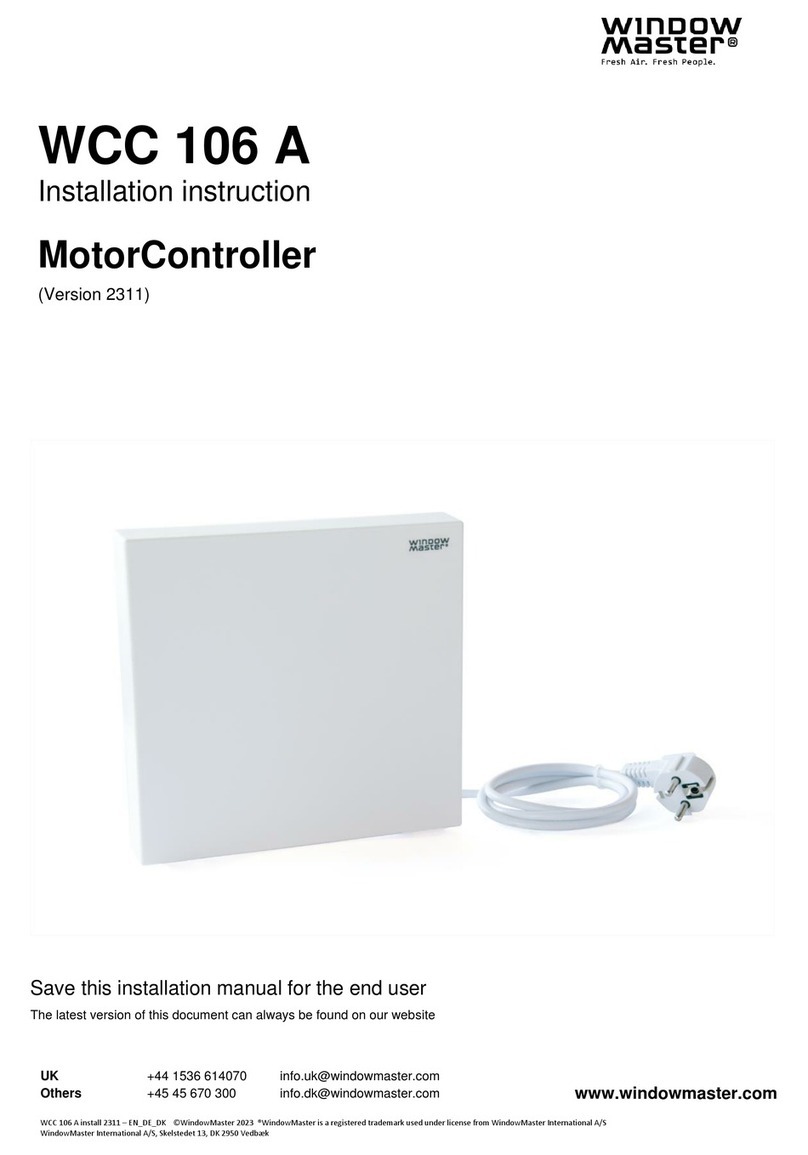
WindowMaster
WindowMaster WCC 106 A installation instructions
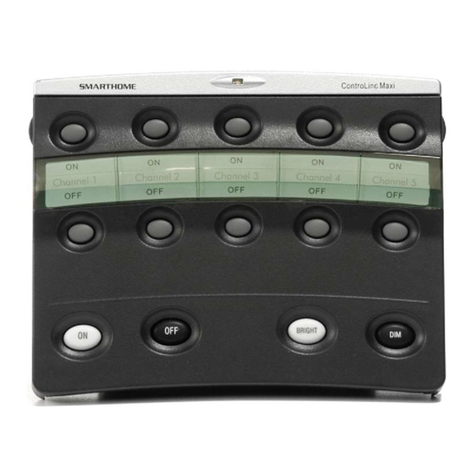
smart home
smart home ControLinc Maxi 4071 quick start guide
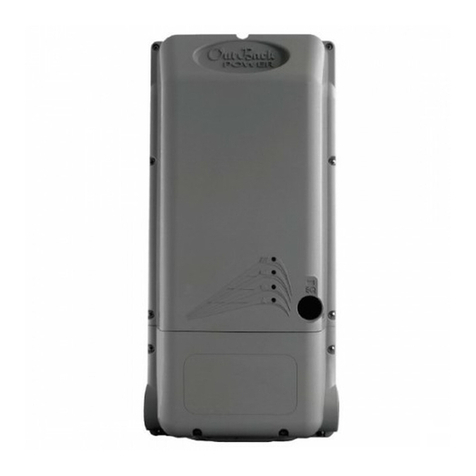
OutBack Power
OutBack Power FLEXmax 100 owner's manual
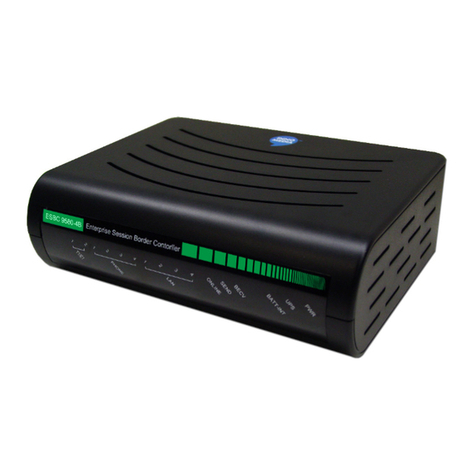
InnoMedia
InnoMedia ESBC 9580-4B Quick install guide
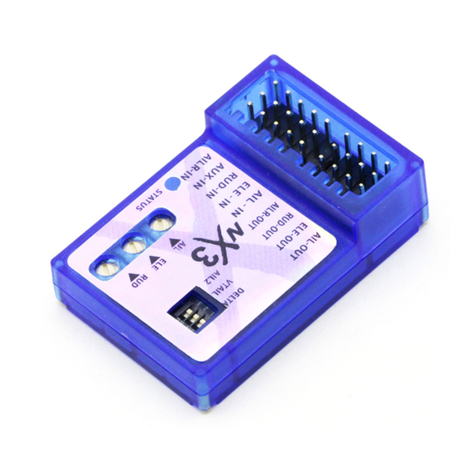
Orange RX
Orange RX MAT NX3 EVO manual
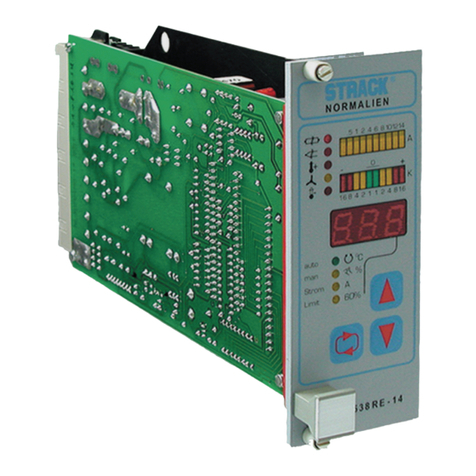
Strack
Strack Z7538 Operating instruction
